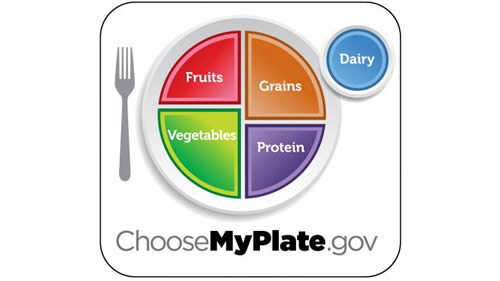Lesson 9: Basic Nutrition
Attention

Visit the Choose my Plate website!
Learning Outcomes
Upon completion of this lesson's material, students will be able
- Demonstrate knowledge of healthy eating habits for young children
- Create a menu of healthy meals and snacks for young children
- Discuss appropriate nutrition activities for young children
Teaching
Read Chapter 6 SNH
Children need nutritious food to grow and develop properly. Both kids and adults should eat a balance of fruits, vegetables, grains, proteins and dairy daily, however children eat significantly smaller portions than adults.
Here is a link to the My Plate (http://www.choosemyplate.gov/myplate-daily-checklist-preschoolers) website, created by the USDA (United States Department of Agriculture) to give guidance around healthy eating and exercise for young children.
As you can see, the plate icon is divided into sections that visually show you how you should fill a plate. Vegetables should take up the most space, followed by grains and then fruits and protein. The glass represents milk, but dairy can also be provided as yogurt or cheese. This does not include “empty calories” such as calories from sugar and fats that are not necessary to support growth and development.
The American Academy of Pediatrics recommends that infants from birth to age one be fed breast milk or formula. AAP also suggests children ages 1-2 should have whole milk and children over the age of two should have low fat or skim milk. This is because healthy fat intake is important in brain and cell development in the early years, but preschool children do not require a large quantity of dietary fat like infants and toddlers. Children who are lactose intolerant can usually have soy products instead.
Child care centers can either require parents to provide meals and snacks, or they can prepare and serve their own menu. The Child and Adult Care Food Program is a benefit program from the USDA that reimburses some food expenses to centers who provide meals. Because it is supported by the USDA, centers who choose to participate are asked to submit menus and provide foods that are healthy and fulfill the My Plate requirements. This is similar to the National School Lunch program which funds schools to provide meals to students.
Water is an essential nutrient that we all need. It is important to provide children with access to water throughout the day. Although water can be found in many fruits and vegetables, the best way for children to consume it, is to drink it. When you teach children to hydrate themselves with water, you are helping them to establish a healthy lifetime habit. Maine Rules for the Licensing of Child Care Facilities requires centers to send water samples to the state lab for regular testing. This is to ensure that the water is free of contaminants and safe to drink.
Teaching children about healthy eating and physical activity should be part of your curriculum. Lesson plans should address healthy food choices, encourage being active and educate children about drinking water and eating fruits and vegetables.
Cooking with children is always a fun and educational activity. There are many child friendly cook books and ideas on line. Always remember safety first and monitor children at all times. But kids can be accomplished cooks. Allow them to use butter knives to cut vegetables or put their own peanut butter on toast. Encourage them to choose fruits and yogurts to put in a blender to make a smoothie. When children make choices and are involved in the food preparation process, they are more likely to try and eat new foods.
The National Association for the Education of Young Children gives guidance and support for cooking with children. (http://families.naeyc.org/WOYC/children-learn-so-much-cooking) This article is a good reference for both teachers and families.
Assessment
Lesson 9 Quiz
Lesson Quizzes will consist of material from the lesson, the discussions, and from assigned reading. Questions will be True/False, Multiple Choice, and Short Answer. Be sure to review all the Lesson and Reading material prior to starting this quiz.
Lesson 9 Assignment
You own a family child care center who participates in the USDA CACFP program. You have children ages 2-5 in your care. Plan a weekly menu of 1 lunch and 2 snacks per day for 5 days which would qualify for this program as well as meet the My Plate guidelines. Write at least one paragraph describing how you could safely involve the children in your center in meal preparation or planning.

Lesson 9 Discussion
Share your favorite healthy cooking with children activity.